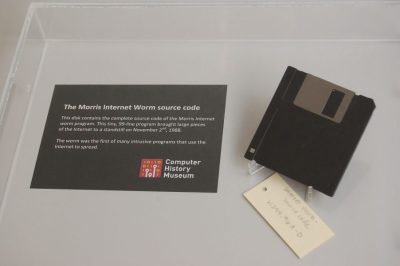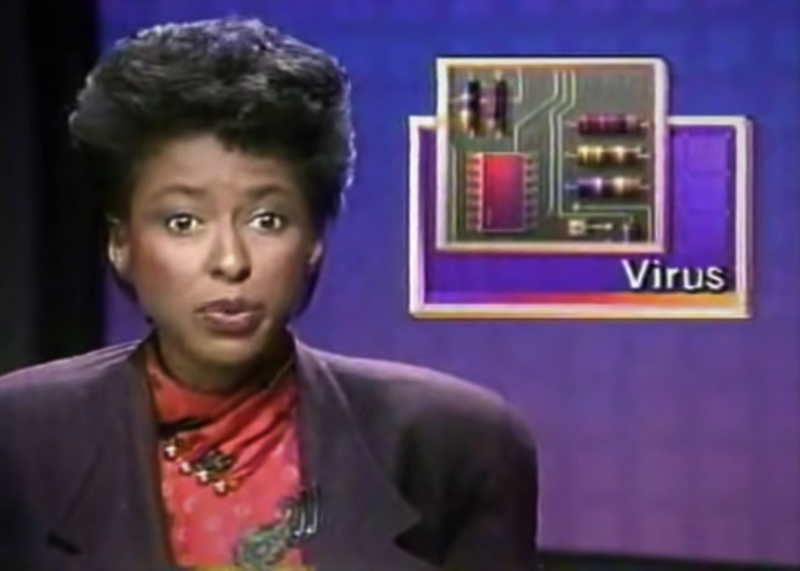It was a cold autumn night in 1988. The people of Cambridge, Massachusetts lay asleep in their beds unaware of the future horror about to be unleashed from the labs of the nearby college. It was a virus, but not just any virus. This virus was a computer program whose only mission was to infect every machine it could come in contact with. Just a few deft keystrokes is all that separated law abiding citizens from the…over the top reporting in this throwback news reel posted by [Kahvowa].

To be fair, the concept of a computer virus certainly warranted a bit of explanation for folks in the era of Miami Vice. The only places where people would likely run into multiple computers all hooked together was a bank or a college campus. MIT was the campus in question for this news report as it served as ground zero for the Morris Worm virus.
Named after its creator, Robert Tappan Morris, the Morris Worm was one of the first programs to replicate itself via vulnerabilities in networked computer systems. Its author intended the program to be a benign method of pointing out holes, however, it ended up copying itself onto systems multiple times to the point of crashing. Removing the virus from an infected machine often took multiple days, and the total damage of the virus was estimated to be in the millions of dollars.
In an attempt to anonymize himself, Morris initially launched his worm program from a computer lab at MIT as he was studying at Cornell at the time. It didn’t work. Morris would go onto to be the first person to receive a felony conviction under the 1986 Computer Fraud and Abuse Act. After the appeals process, he received a sentence a community service and a fine. After college Morris co-founded the online web store software company Viaweb that Yahoo! would acquire in 1998 for 49 million dollars. Years later in an ironic twist, Morris would return to academia as a professor at MIT’s department of Electrical Engineering and Computer Science.
Interested in some info on viruses of a different nature? Check out this brief history on viruses from last year.















Cheesy or not, the Morris worm was a very big deal at the time. Dr Dobbs Journal had a feature article IIRC titled ‘The Internet Menace’ with a striking cover illustration, and went into it in-depth.
I remember it well as I supported our customers on Unix at that time, however it only affected internet-connected BSD and not the corporate-connected System V boxes I maintained, so to me it was merely interesting rather than something I had to deal with.
It was 1983 when i read from scientific American about virus .. it pointed to a fabric that the design is replicated.
.
No real damage at those times .
.i even wonder if it has any use.
NOW.. its very useful.. computers need to be OS upgraded.. system replaced.. monies gone.. countris BizMuLLaGh.
.
.
Did they ever find out who created it?
The love bug gets no love? 😂
It was so early, it didn’t affect many computers. Just the ones that mattered. If yiu wanted to affect lots if users, you’d need to infect a common program, and let people share, or upload it to BBSs.
But yes, it made it into the news, even though it was before the public really knew about the internet.
The “internet” wasn’t really open to the general public at that point , either. People often forget about that.
Universities, NASA etc. were about the first to access the medium that was a transition between Arpanet and Internet.
What people often had access to were BBSes (mailboxes), Packet-Radio (AX.25) via Amateur Radio and online services like GENIE, CompuServe, Minitel/BTX in parts of Europe etc.
Another thing that people, or historians, forgot about, was X.25.
And no, just not the protocol. I mean those WANs around the globe that did build upon it.
There used to be many X.25 networks around the globe that could interconnect with each other. Many were based on permanent telephone connections. That way, e-mails were internationally exchanged years before the “Internet” was opened.
Examples:
https://en.wikipedia.org/wiki/X.25
https://en.wikipedia.org/wiki/DATAPAC
Here in Germany, we had Datex-P, for example.
It gave you access to mainframes, databases around the globe. Since the 1970s, if memory serves.
All you needed was a PAD (Paket Assembler Disassembler) to dial into with your serial terminal or computer.
Then you could call a computer in the US, Canada, Australia, Japan etc – without paying horrendous phone bills.
In some cases, the destination system paid your bills, also.
Unfortunately, the hacker scene or demoscene never heard about these things. X.25 was commercial/professional stuff. All they had were BBSes or Fidonet, at best.
I faintly remember that his father worked in comp security/IT as well. Somewhat embarrassing for his son to be infamous with this situation.
It’s worse than that. He was the chief scientist of the NSA’s National Computer Security Center. Ouch.
The whole thing is discussed in “The Cuckoo’s Egg”. Robert Morris Sr. was an early contributor (algorithm design) to UNIX when he was working at Bell Labs before going to the NSA — one of the original wizards Cliff meets during his hunt.
His son, the worm author, went on to a successful academic career along with being a founding partner of Y Combinator.
The man’s son not the man himself but a completely separate human being was trying to write a program that found weaknesses but it didn’t go as planned. I fail to see how that’s embarrassing for the father.
Ah. Osborne I at 1:53. Those were the days. (I hacked mine with extra cooling fans in the back, and a few other things. And it was a nice warm fuzzy 50 Hz buzz to get that jolt from the keyboard ground loops. (I was in Europe at the time.)
Actually that is the Osborne II.
The article uses the terms “worm” and “virus” interchangeably, but they’re not the same. Worms can self-replicate (infect other systems) without human interaction. That’s why the Morris worm spread so quickly. Viruses require a human to run the program it’s attached to in order for it to infect a new computer.
“Years later in an ironic twist,”
In the words of Bender Rodriguez: “It’s not ironic, it’s just coincidental.”
The ironic bit was that he landed at MIT. There’s certainly nothing coincidental about someone interested in computers making their career in computer science…
How many convicted hackers get out of jail and are like “well, I guess I could always become a florist”?
Kevin Mitnick, a hacker famously arrested and convicted in the 90’s, would be another example of this irony. He now runs his own security consulting firm, provides penetration testing services, as well as Social Engineering and security awareness training for corporations and government agencies.
It’s almost likem they break the law as a job interview. Then later they can turn around and get a job.
“Mafiaboy”, who was local, I think went into security after getting busted. It’s pretty common.
For a moment there, I thought the discussion had veered into presidential politics!
I’m still not sure that falls under the definition of ironic, but I’m willing to agree to disagree on the matter.
ET for the atari, gotta love it
A friend of mine and I created a simple worm in 1979 on IBM Time Sharing Option computers. It spread through our department quickly and scared the hell out of us. We just managed to delete it before it spread more widely. Playing with fire is always dangerous.
Play with fire
You burn your fingers
And lose your home in the flames
“The Mob Rules” Blue Oyster Cult
Black Sabbath. Ugh.
Was the footage of the ET game in there just to show us how awful it was?
I can only imagine it was to show how frustrating it can be to contain a virus, since I can clearly recall how frustrated I was as a kid trying to figure out how to win that game or even understand what was going on most of the time!
more like it was the only footage they readily had on hand. cause they were just finished doing segments on how youth was being corrupted by evil video games and heavy metal music.
I worked at Cornell when that went down. Things were a lot different back in those days. It is hard to put yourself back to just what the state of tech was, but mail relays were pretty much all open, almost all unix machines had telnet open. The mit media labs had machines you could log onto freely. They nicely acknowledged that the OS was not perfect and they could be crashed, please don’t. It was a kinder and gentler era. A lot less people on the net. Mp3’s were not here yet, jpeg was, and I think gopher was the thing, the web proper was a little bit in the future if I recall right.
Was at grad school back then, the main compus DEC Vax machine came to crawl that afternoon. I was admin for 5 Sun workstations, they didn’t get affected fortunately.
Later, my mom met Clifford Stoll at book signing in Los Alamos.
I remember the pre-internet days when viruses / worms spread via floppy disks, I was a CME Computer Maintenance Engineer at the time.
There was one (a boot sector virus) that the staff were resolving by copying off files. System formatting the HDD. Installing the OS and copying files back.
I showed my boss a shortcut. Just type in FDISK /MBR and it takes only seconds.
I used to always stir my boss in-front of the other staff. He asked what /MBR does so I told him that it was an undocumented switch that re-writes the master boot record, overwriting the virus.
Then he asked how you find out about undocumented switches so I told him that you can’t because they’re undocumented and I walked away leaving him standing there confused in front of all the other it lab staff.
A method of virus propagation I’m surprised was never done. Remember the DOS disk support in Mac OS before OS X? Create a Mac virus that patches the DOS support then deletes itself. It puts a payload of a PC/DOS boot sector virus into the DOS filesystem driver. Since the Mac instantly writes a desktop and .trashes folder to any FAT media it comes in contact with, without asking permission, the users would think nothing of it as the Mac would also be copying the boot sector virus.
The trickier part would be putting the DOS support infecter onto a PC floppy so that when the disk is put into an uninfected Mac it would get infected to spread the virus and Mac infecter to more DOS floppies, Zip disks, etc.
It would be an interesting experiment to try, since it would no longer be a hazard to something like a large number of PCs at a school.
Thank you for sharing this video!!!! It was amazing!
Why was it chest? This is what we get for journalist from people who think they know it all
“Cheesy” might be a bit judgmental coming from technical people who often don’t bother to care about technical details such as differentiating between viruses and Trojans.
And the date is wrong. It was in November of 1988 when it happened, by then Cliff had moved across the country to work at a new observatory, when the whole thing happened. The book he wrote (with help) mentions it in the epilog to the whole book.